Old and New, Delhi Fills Up on Street Food Day and Night
The Boston Globe - Travel - Sunday, September 19, 2010
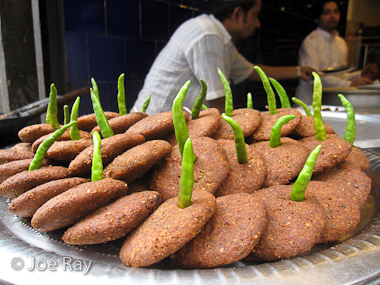
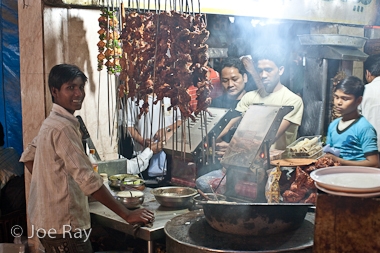
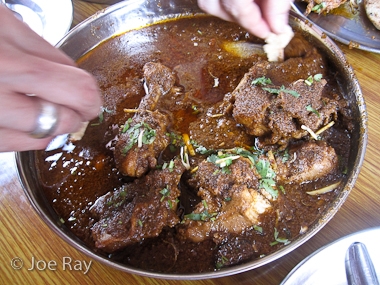
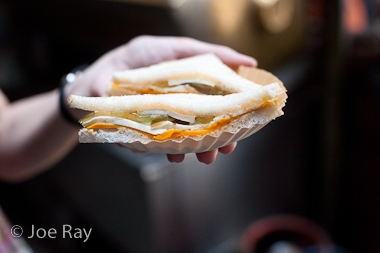
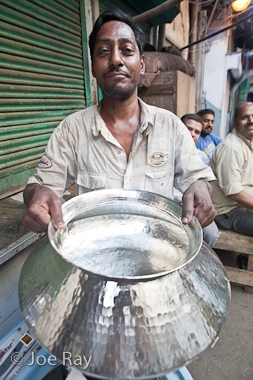
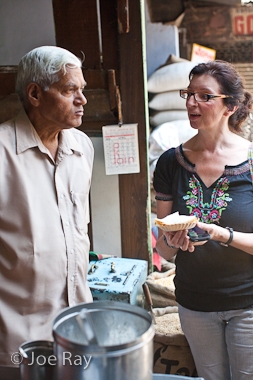
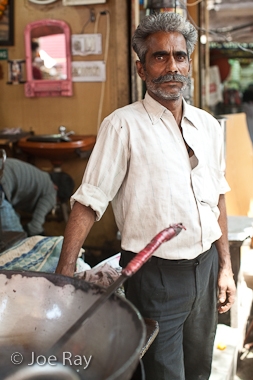
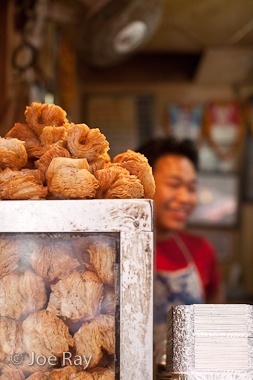
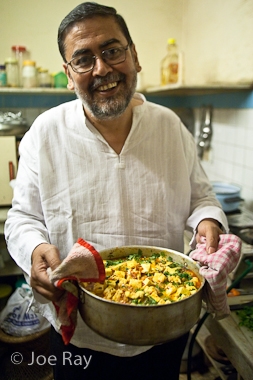
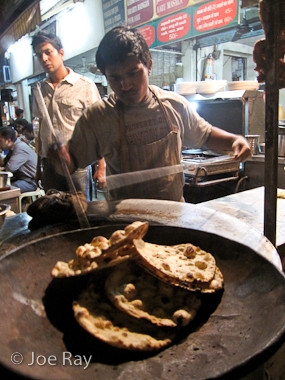
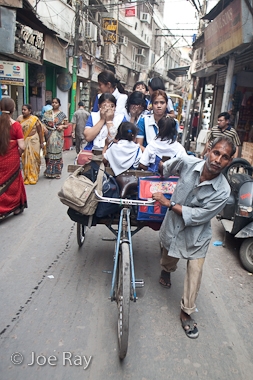
This city begins on the street where I spy an indoor-outdoor, sit-stand joint called Al Bake with a team of cooks trimming cooked lamb from upright spits before going crazy on the trimmed meat with a pair of cleavers. Wap! Wap! Wap! Wap! It leaves a mound of heavenly-smelling minced lamb and spice that, wrapped in flatbread, make one mean, minimalist, New Delhi-style shawarma.
At dinner, I corral a few friends and guilt-trip them into joining me at Al Bake. Munching away while sitting on plastic chairs under the stars, we are not disappointed. While Delhi can feel hard to connect with, exploring the street food scene is a direct path to its core.
“In India, life happens on the street,’’ says a friend, and nowhere is that more evident than in the Delhi street food scene, particularly in the pulsing heart of Old Delhi.
Indian street food explodes all day, from sidewalk-straddling sugar cane juice stands and kebab kiosks to full-out kitchens of men working like blazes to produce specialty items. For some of India’s best food, do a bit of research and make a list of places to try, haggle with a cycle rickshaw driver, and then plunge into the bazaar.
Old Delhi is a mishmash of stunning balconies, colossal mosques and temples, and atrocious modern architecture that begins crumbling as soon as the cement sets. Masses of wires dangle from buildings and telephone poles giving it a post-apocalyptic feel. There are hordes of people, wholesale vendors of every kind, entire streets and micro-neighborhoods devoted to metalworks, electronics, wedding supplies, spices, silk, and jewelry. Rickshaw wallahs cart scores of uniformed schoolchildren on their three-wheeled cycles, porters haul plastic, cooking oil, rebar, or great slabs of paper on their heads, backs, and carts. It’s a crush of hungry humanity and everyone needs a place to eat.
It’s also such a maze that finding the food stalls (finding anyplace, for that matter) can be half the challenge. Directions in local newspaper articles routinely suggest heading down a better-known street to a well-known landmark before doubling back 100 feet to make a turn you would otherwise miss. Even Google Maps gives up the ghost when you try to zoom in.
One of those first places I try, the Ashok & Ashok Meat Dhabha, makes the effort worth it. A tipster has sent me here to try mutton korma, a house specialty available only two days a week, where the spice-laden meat is seared, then slow-cooked over low heat.
“We’re out of mutton,’’ says the fellow taking orders in the sidewalk’s fray. “Have the chicken.’’ The stand has been open half an hour and the signature dish is sold out. Live and learn.
Or not.
The chicken korma arrives on a metal plate, a vessel for a host of spices and the clarified butter known as ghee. The chicken has a flavor so incredibly deep and earthy, it tastes as if its claws are still on the ground. It’s served with a dish of biryani rice, flecked yellow-orange with saffron, and a continuous supply of whole-grain chapati, or flatbread; either is a perfect means for getting more of the curry into your mouth.
If you need a breakthrough moment for Indian street food, this would be it.
Accommodations are spartan. Wooden utility tables take up most of the sidewalk in front and there’s an awning-tarp combination protecting some diners from the sun. You eat on your feet, licking your fingers and thanking the heavens.
“I can have a lot of Byzantine notions, but five-star hotel food isn’t very good,’’ says Rahul Verma, my Ashok & Ashok tipster, who has been singing the glories of Delhi’s street food for 20 years for The Hindu newspaper.
“I love it. I get energized,’’ he says. “If you look at street food, you get the whole city.’’
With a Rolodex of the best places to eat in the warren of Old Delhi, Verma seems custom-made for his job. He’s the kind of guy who holds court at the Press Club of India, continually dispersing spot-on information on the best places to eat and topping off your beer whenever you’re not looking.
“Street food is the closest link to culture and society and it’s evolved over the centuries,’’ he says, “and it’s cheap.’’
A perversely proud two-time survivor of jaundice, Verma has a strict set of ground rules to minimize the chances of catching traveler’s illnesses affectionately known as Delhi Belly.
1. “Go someplace busy’’ — the faster the turnover, the fresher the food.
2. “Eat food that is cooked in front of you’’ — to minimize the risk from food-borne bacteria.
3. “Always carry bottled water.’’
4. “Don’t touch the sliced onions.’’ They may have been staying fresh in a bowl of water.
With that and a handshake, he sets me loose on the city with a list of his favorites. I enlist Scottish-born journalist Pamela Timms whose Eat and Dust street food blog was recently voted one of India’s top five food sites.
We take a cycle rickshaw to Chawri Bazar, one of Old Delhi’s main drags (picture a chaotic “Indiana Jones’’-esque street scene, double the number of people, make sure they’re all sweating profusely, and you get the idea), and we head to Jain Coffee House, one of Timms’s new favorites.
We walk through an alley I wouldn’t want to head down alone at night and come out in an aqua-hued courtyard full of wholesalers. It’s a calm world, separate from the bazaar half a block away.
“There it is,’’ she says, pointing toward a white-haired man sifting wheat. Hidden in the corner is the tiniest of kitchens, taking up just enough space to make coffee, chai, and some peculiar specialties.
She orders a pair of mango sandwiches that arrive with the crusts cut off.
“Their sandwiches are usually fruit jelly with thin slices of paneer [a type of fresh cheese] and grape or pomegranate, and slices of mango or apple,’’ she says. “It depends on what’s in season.’’
Ours, which we eat while sitting on sacks of grain, are unlike anything I’ve seen in India — more, say, a fresh and slightly healthier version of the cream cheese and jelly I loved as a kid.
“They’re not traditional, but Jain has been around fifty years,’’ she says, smiling at the contradiction. “It’s a pretty unique enterprise.’’
We head to check out one of Verma’s suggestions, Manohar Dhaba, which is nestled into the electronics bazaar at the end of Chandni Chowk, across from Delhi’s historic Red Fort. Here, you eat “japani samosas,’’ one-of-a-kind stuffed mille-feuille with muddled, and not necessarily Japanese origins.
We take a bite — the flaky, cube-like puff hides an interior stuffed with peas and potatoes — which make a fantastic, if heavy mouthful.
“This would come in the ‘hangover food’ category,’’ says Timms, putting a fine point on the inherent greasy goodness.
From here, we cheat a bit and stop at a sit-down restaurant that’s on both Timms and Verma’s lists: Hotel Adarsh Niwas.
“Hotel’’ gets a bit of a stretch in Delhi, encompassing accommodation-free eateries. Inside, owner Satnarayan Sharma sits on the edge of a booth seat, his legs folded under him. We buy brass tokens at the register and hand them to the waiter without a word; he returns in a few moments with the restaurant’s signature thali — a large metal plate covered with smaller metal plates, each with a different dish: dal, curries, and even sweeter options to be eaten alongside the savory. One cup has a thin yogurt with puffed grains — something I’d be tempted to eat for breakfast or as an afternoon snack, yet in the context of the other options, it makes perfect sense. There’s also warm gulab jamun, sweet milk solids typically flavored with cardamom or rosewater that remind me of a perfect pancake from my youth.
We’re stuffed to the gills but Timms wants to make sure I have what I need.
“Need any other places?’’ she says.
“Not unless we’re within 10 feet of one,’’ I reply, raising the white flag.
She understands, but she’s a good foodie, and I can see the gears turning as we head out the door.
That evening, I take a walk in the Nizamuddin neighborhood where I’m staying. The mercury is still high and a block away from the flat, I hear the tinkling bell of the popsicle cart. All the man sells is three sizes of “kulfi,’’ a dense ice cream cousin traditionally made by boiling down sweetened milk. This version has traces of cinnamon and cardamom — cool, soothing goodness on a stick.
Follow me on Twitter: @joe_diner and on Facebook.
If You Go
How to plan

You need a plan of attack to know where to go on an Old Delhi street food jag. To get started, find a few destinations on the blogs of food writers Pamela Timms and Rahul Verma.

Even if you know the places you’d like to visit, your best bet is to find a cycle rickshaw driver. You should be able to negotiate a rate of around 200 rupees (about $4.30) per hour.

Cycle rickshaw driver Rahul Pal (+91 9871533849) knows many of Timms and Verma’s favorite places and can help find others.

Where to eat

Prices vary, but it is hard to spend more than the equivalent of $5 on a meal at any of the following establishments.

Hotel Adarsh Niwas

483 Haider Kuli Corner (below Andhra Bank)

Chandni Chowk

+91 (0)11 2392 9139

Al Bake

22 Community Center

New Friends Colony

+91 (0)11 3297 2881

Ashok & Ashok Meat Dhaba

42 Subhas Chowk, Basti Harphool Singh
Sadhar Thana Road

+91 989 1776283

Manohar Dhaba

38/240 Diwan Hall Road
Old Lajpat Rai Market (across from Red Fort Main entrance)

+91 (0)11 4139 1909

Jain Coffee House

Directions from the Eat and Dust blog: From Chawri Bazar Metro walk along Chawri Bazar until almost at the left turn into Nai Sarak. On your left is a small gully, Raghu Ganj; walk in and turn left, Jain Coffee House is the grain store at the far left.
See the story as it ran in the print version: page 1, page 2.